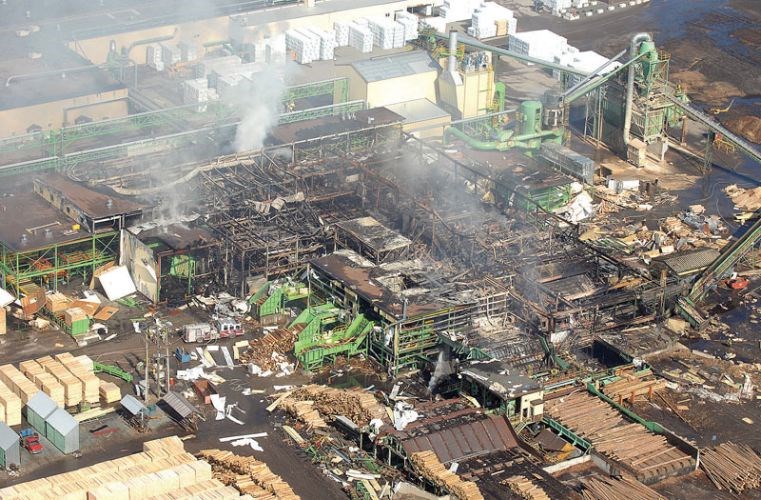A WorkSafe B.C.'s lead investigator elaborated Wednesday during a coroner's inquest on what he believes happened when a sawdust-fueled explosion ripped through Lakeland Mills sawmill nearly three years ago.Alan Little and Glenn Roche died from the injuries they suffered in the April 23, 2012 explosion which also injured more than 20 others, several seriously.
Like he did when giving a presentation Tuesday, Paul Orr said the ignition point was a fan on a gear reducer in the sawmill's basement that heated up to the point where it ignited some surrounding sawdust after coming lose and jamming into a screen.
A five-horsepower motor was used to power a conveyor beneath the mill's slasher deck. Because it spins at 1,750 revolutions per minute, it is coupled to a gear reducer to bring down the speed at the conveyor's drive sprocket.
Orr said the fan was mounted at one end of the reducer and used to keep dust away from the assembly. But it had come loose, worked to the end of the shaft and jammed into a fibreglass screen and eventually came to a stop.
The shaft of the gear reducer continued to rotate in contact with the bore of the alloy fan and lab tests indicate the subsequent friction caused the fan's collar to reach a temperature of 577 C. The fan had also dislodged the screen and moved it further down, allowing dust into the housing where it was located.
There was dust from the conveyor dumping wood waste into another vibrating conveyer "plus all the other dust that was coming down from operating level above," Orr said.
"That dust started to burn and it started to increase in intensity as it fed upon dust upon dust. It eventually expanded in both pressure and heat so as that pressure expanded, it dislodged other dusts that had settled or not and eventually found a place where there was a concentration that turned into a full deflagration," Orr said.
A deflagration can be described as a slower-motion explosion in that it travels at less than the speed of sound, as opposed to a detonation, which expands a greater than the speed of sound.
"That deflagration produced pressures which could not be held in that area," Orr said. "It contacted the north wall and went upwards and into the operating floor and went through the floor openings around the headrigs. It went up the stairwell, to where the slasher deck was, and basically exploded at that point into the rupture of the roof and the massive fireball that is described by many witnesses as traveling through the operating floor."
Investigators determined the event began at 9:37 a.m., seven minutes after the night shift's lunch break had begun.
Roche had a habit of blowing down the "eyes" or sensors on the large headrig he operated before going into the lunchroom and he was in the vicinity of the machine when the explosion erupted. Little was in the mill's computer room, close by, and both suffered severe burns that they were unable to survive.
Orr dismissed methane gas as helping to fuel the explosion.
Two weeks before the explosion, a foul smell coming from beneath the mill's small headrig had been reported but Orr said a barrel containing grease as well as some old gloves were found and when removed, the smell went away.
But in response to concerns raised, Lakeland hired an environmental firm to put in 10 test wells around the footprints of the sawmill and the nearby planer mill and, on June 19, 2012, two of those wells showed levels above the acceptable limit.
But Orr said the samples were problematic and WorkSafe followed up with testing of its own that found "absolutely no evidence of methane in the mill."
In later testimony, Jason Rustad, the mill's maintenance supervisor, said he did not recall getting into an argument with one Lakeland employee and being warned by another that the mill would blow up following a smaller explosion Jan. 19, 2012 at the large headrig where Roche was working.
The inquest had heard Roche was blowing down the larged headrig when a fireball burst upwards as high as 50 feet as flames climbed airborne dust. Rustad said he was not in the mill at the time and simply did did not recall anyone telling him about a large fireball.
Earlier in the inquest, small headrig operator Brian Primrose said he got into an argument with Rustad about the mill's cleanliness following the incident and charge hand Bruce Germyn said Lakeland was "one machine away" from a major explosion.
As maintenance supervisor, Rustad said he oversaw a two-man cleanup crew whose responsibility was limited largely to cleaning up areas where millwrights and electricians were about to work.
He said they would help out a clean up crew working under the operating supervisor when they could but also had other duties and, for a time, was down to one person. However, it was brought back up to two about a month before the explosion.
Also on Wednesday, Dennis Perrault, who was Prince George Fire Rescue's chief fire prevention officer at the time, said the Jan. 19 incident was never reported to PGFR nor were firefighters called to the scene. He said PGFR would have investigated the incident if it was notified.
The inquest, which is expected to last until at least March 23 and to have heard from 47 witnesses by the time it has ended, continues Thursday at the Prince George courthouse, 9 a.m. start.



